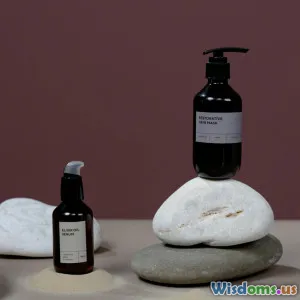
How to Identify Harmful Ingredients in Beauty Products
15 min read Learn how to spot harmful ingredients in beauty products to protect your skin and health. (0 Reviews)
How to Identify Harmful Ingredients in Beauty Products
Stepping into the world of beauty products can be both exciting and overwhelming. With glossy packaging, shiny labels, and persuasive marketing, it's easy to forget that some products may harbor ingredients potentially harmful to your health. Knowing what you're putting on your skin isn't just a matter of beauty—it’s about safety, health, and making informed choices. This guide will help you navigate ingredient labels, understand what substances to watch out for, and empower you to make the best decisions for your skin and your well-being.
Understanding Ingredient Labels

One of the trickiest aspects of choosing safe beauty products lies in deciphering their ingredient lists. Companies are required by law to disclose contents, but sometimes the terminology used can be confusing or intentionally vague. Here are some pointers to interpret labels effectively:
Read INCI Names Carefully
INCI stands for International Nomenclature of Cosmetic Ingredients, a standardized system recognized globally. For example, 'Tocopherol' for Vitamin E or 'Butyrospermum Parkii' for shea butter. This uniformity helps you recognize familiar substances even among foreign products. However, it can be tricky with synthetic chemicals, which often have longer, less familiar names.
Example:
- Parabens might be listed as methylparaben, butylparaben, propylparaben, or ethylparaben.
- Fragrance may simply appear as fragrance or parfum, a term that can hide dozens of undisclosed chemicals within.
Order of Ingredients Matters
Ingredients are listed in descending order of concentration, starting with the most abundant. If a harmful ingredient appears in the top five, it's present in significant quantity. However, be vigilant: ingredients present in less than 1% can be listed in any order after the others, making it harder to assess their impact by position alone.
Tip: If you notice sensitive ingredients like artificial dyes, parabens, or formaldehyde releasers near the top of the list, consider avoiding the product.
Red Flags: Harmful Ingredients to Watch Out For

A few critical ingredients, commonly linked with skin irritation, allergies, or even health risks, often appear in everyday cosmetics. Familiarizing yourself with these can prove invaluable.
Parabens
What are they? Parabens are preservatives used to extend shelf life by preventing the growth of mold and bacteria.
Risks: Some parabens mimic estrogen in the body and have raised concerns about hormonal disruption. Their presence is particularly controversial in products used on compromised or sensitive skin, or those left on the skin for long periods, such as lotions and deodorants.
Common forms: Methylparaben, butylparaben, propylparaben, ethylparaben.
Phthalates
Role: Often found in fragrances to help products maintain their scent.
Risks: Suggested links to endocrine disruption, developmental, and reproductive toxicity.
How to spot: Rarely labeled simply—often hidden within the term fragrance or parfum, making their presence hard to detect without direct manufacturer clarity.
Formaldehyde and Formaldehyde Releasers
Use: Preservatives in nail polishes, hair smoothening treatments, and some creams.
Risks: Classified as a human carcinogen; can trigger allergies and skin irritation.
Listed as: Formaldehyde, quaternium-15, DMDM hydantoin, imidazolidinyl urea, and diazolidinyl urea.
Sodium Lauryl Sulfate (SLS) and Sodium Laureth Sulfate (SLES)
Purpose: Create foam and are found in cleansers, shampoos, and toothpaste.
Risks: Known to strip natural oils, cause skin dryness, and irritation for sensitive individuals.
Synthetic Colors and Dyes
Noted as: FD&C or D&C followed by a color and number (e.g., FD&C Red 40).
Risks: Artificial dyes may cause skin sensitivities and are banned in several countries due to links with allergic reactions and long-term toxicity.
Checking for Allergens: Avoiding Irritation and Sensitizers

Beauty products designed for even the most sensitive skin types may contain potential allergens. Here’s how to spot and avoid them:
Common Irritants
- Fragrances: Even natural essential oils can trigger reactions in sensitive individuals.
- Preservatives: Methylisothiazolinone and methylchloroisothiazolinone are notorious for causing dermatitis.
- Lanolin: A natural, wool-derived emollient that can provoke allergic reactions.
Reactions to Watch For
- Redness and itching after application
- Small bumps or blisters
- Dry patches that do not resolve with usual care
How to Minimize Risk
- Do a patch test: Apply a small amount behind your ear or in the crook of your elbow, wait 24-48 hours for any reaction.
- Opt for products labeled 'fragrance-free' instead of 'unscented,' as the latter may contain masking fragrances.
- Study the ingredient list of familiar products that caused you irritation to identify repeat offenders.
Pro Tip: The app-based database, Skin Deep by the Environmental Working Group, allows you to look up products and ingredients for allergenic potential and toxicity levels.
Natural vs. Synthetic: Debunking the Myth

The term 'natural' appears everywhere, conveying safety and purity, but not all natural ingredients are low-risk. Likewise, not every synthetic chemical is inherently harmful.
Natural Doesn’t Mean Non-Allergenic
Consider common natural irritants:
- Essential oils (e.g., lavender, citrus) may cause reactions in some people.
- Poison ivy and poison oak are natural but toxic to touch!
The Case for Some Synthetics
Certain synthetics are designed for stable, hypoallergenic usage. For example, synthetic hyaluronic acid in serums delivers hydration while reducing contamination risk versus animal-derived alternatives.
Greenwashing Tactics to Avoid
Brands may slap "organic," "natural," or "clean" triggers on packaging. These are largely unregulated marketing terms:
- Check for certifications like USDA Organic or Ecocert, which adhere to stricter guidelines.
- Turn over the product and inspect the full ingredient list, as even 'green' products can house traditional preservatives.
Key Insight: Your skin is unique; patch testing applies as much to natural products as to synthetic ones.
Recognizing Potentially Harmful Chemical Families

Understanding broader chemical families can streamline decision-making in the skincare aisle.
Silicones
Types: Dimethicone, cyclopentasiloxane, and cyclohexasiloxane
Purpose: Impart slip and smoothing effect to serums and lotions.
Risks: Generally considered safe; however, may cause buildup on skin and hair, leading to dullness or potential pore-blocking for acne-prone skin.
Petrochemicals
Examples: Mineral oil, petrolatum, paraffin
Concern: Purified forms are generally safe and effective at moisture retention, but lower grades can contain impurities (including PAHs, a carcinogen). Poorly refined petrolatum should never be used.
Alcohols
Simple Alcohols: Ethanol, isopropyl alcohol, benzyl alcohol
Risk: Can unleash dryness, stinging, and irritation in sensitive skin.
Fatty Alcohols: Cetyl, stearyl, cetearyl
Risk: Generally safe, often beneficial for moisture.
Triclosan and Triclocarban
Usage: Antimicrobial agents in soaps and deodorants
Health Issues: Linked to hormone disruption and bacterial resistance; the FDA has banned their use in certain products in the US, but they persist in others.
Tools and Resources: Demystifying the Ingredient Hunt

With technology on your side, avoiding harmful ingredients has never been easier. A few resources stand out:
Ingredient Analysis Apps
- Think Dirty: Scan product barcodes to get ingredient toxicity ratings, detailed breakdowns, and safe alternatives.
- INCI Beauty: Offers visual breakdowns of each ingredient’s safety, purpose, and environmental footprint.
- CodeCheck: Reads UPCs and deciphers product safety worldwide.
Online Ingredient Directories
- Cosmetics Info (maintained by the Personal Care Products Council): Validates regulated uses and safety limits.
- Environmental Working Group's Skin Deep: Provides ingredient-specific research and grades products for health hazards.
How to Use These Tools Effectively
- Check both overall product safety and problematic ingredients in isolation.
- Remember that individual sensitivities can’t be generalized by toxicity ratings—what is safe for one person could be problematic for another.
Real-Life Example: Belinda experienced persistent eye irritation from a seemingly mild mascara boasting a “natural” label. She scanned it with Think Dirty and discovered high concentrations of phenoxyethanol (a preservative with eye-irritation potential) and fragrance hidden under parfum.
Staying Ahead: Tips for Smarter Shopping

Decoding labels only works when you’re actively mindful about what you buy. Here are actionable strategies for every beauty routine:
Check Independent Certifications
- Prefer brands certified by Ecocert, COSMOS, or USDA Organic for tangible safety metrics, not just marketing.
- Look for cruelty-free icons (Leaping Bunny, PETA) to ensure ethical ingredient sourcing and product safety.
Shop Transparent Brands
- Choose brands that publish full ingredient lists and clarify their source and purpose for each component.
- Seek out companies that describe their preservative methods, shelf life, and stability testing—not just buzzwords.
Rotate and Update Your Collection
Cosmetics, like food, expire:
- Oil-based products can go rancid.
- Preservative-free natural options may harbor bacteria after several months.
- Old or contaminated products can spark irritation regardless of ingredient safety.
Consult Professionals for Chronic Issues
Persistent rashes, burning, or acne linked to product use merits consultation. Dermatologists can recommend hypoallergenic and non-comedogenic alternatives best suited for your specific skin type.
Navigating Emerging Ingredients and Trends

The beauty industry never rests, continually introducing new actives—some promising, others untested. Newly popular ingredients often lack extensive safety data and may behave unpredictably on sensitive skin.
Peptides, Acids, and Retinoids
These have clear science-backed benefits when formulated properly, but overuse or careless layering can damage the skin barrier.
Tip: Always introduce actives gradually, patch test, and avoid mixing potentially reactive ingredients (ex: Vitamin C with retinol or acids).
Microbiome-Based Cosmetics
Probiotics and fermented extracts seek to balance natural flora, but also may harbor unwanted bacteria if not preserved correctly. Research is in its infancy.
CBD and Novel Plant Extracts
CBD and obscure botanicals flood the market, often with little scientific backing. Their safety, particularly long-term and in combination with complex formulas, isn’t always established.
Insider Insight: Check for clinical studies or third-party lab testing before trusting new-to-market plant extracts.
Embracing Safe, Effective Beauty Choices
Identifying and avoiding harmful ingredients isn’t about creating fear or swearing off beauty products altogether. Instead, it's about fostering a sense of agency—knowing how to spot red flags, use technology to your advantage, and demand clarity from the brands you trust. As science evolves and new products appear, your willingness to stay informed ensures your beauty routine remains both effective and safe.
The next time you pick up a sleek bottle or trendy new cream, don’t judge the product by its cover. Turn it around, read the ingredients, question the marketing claims, and let knowledge guide your beauty journey.
Rate the Post
User Reviews
Popular Posts















